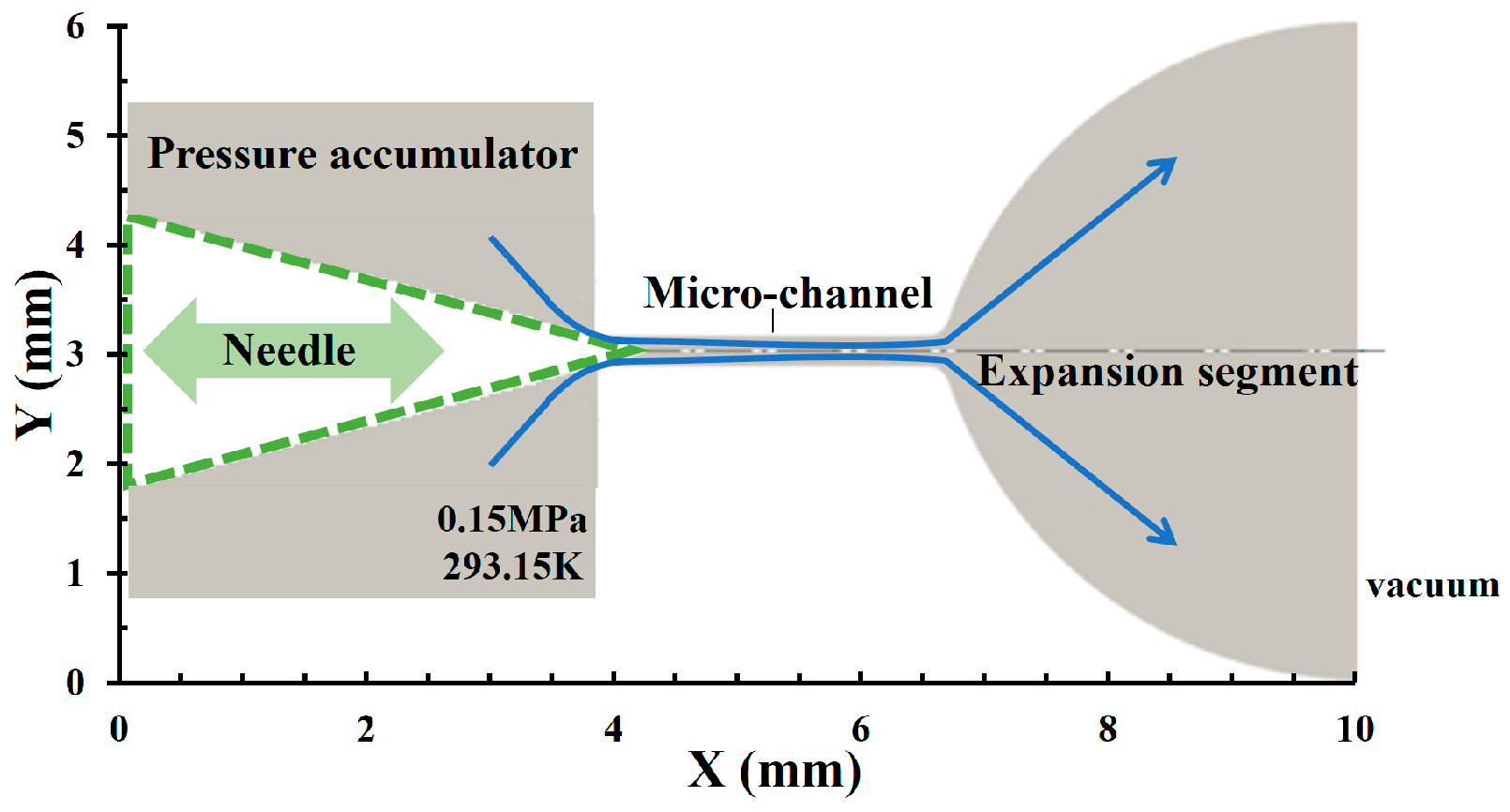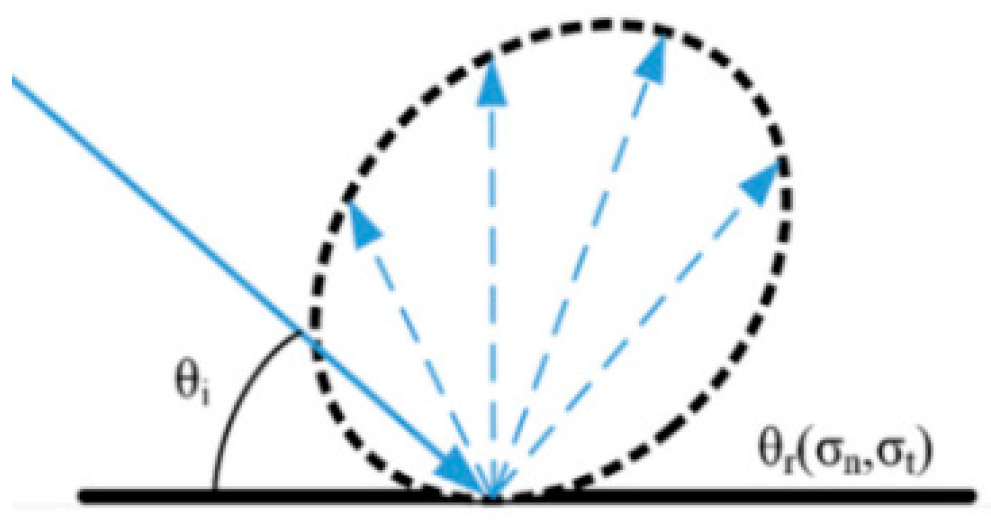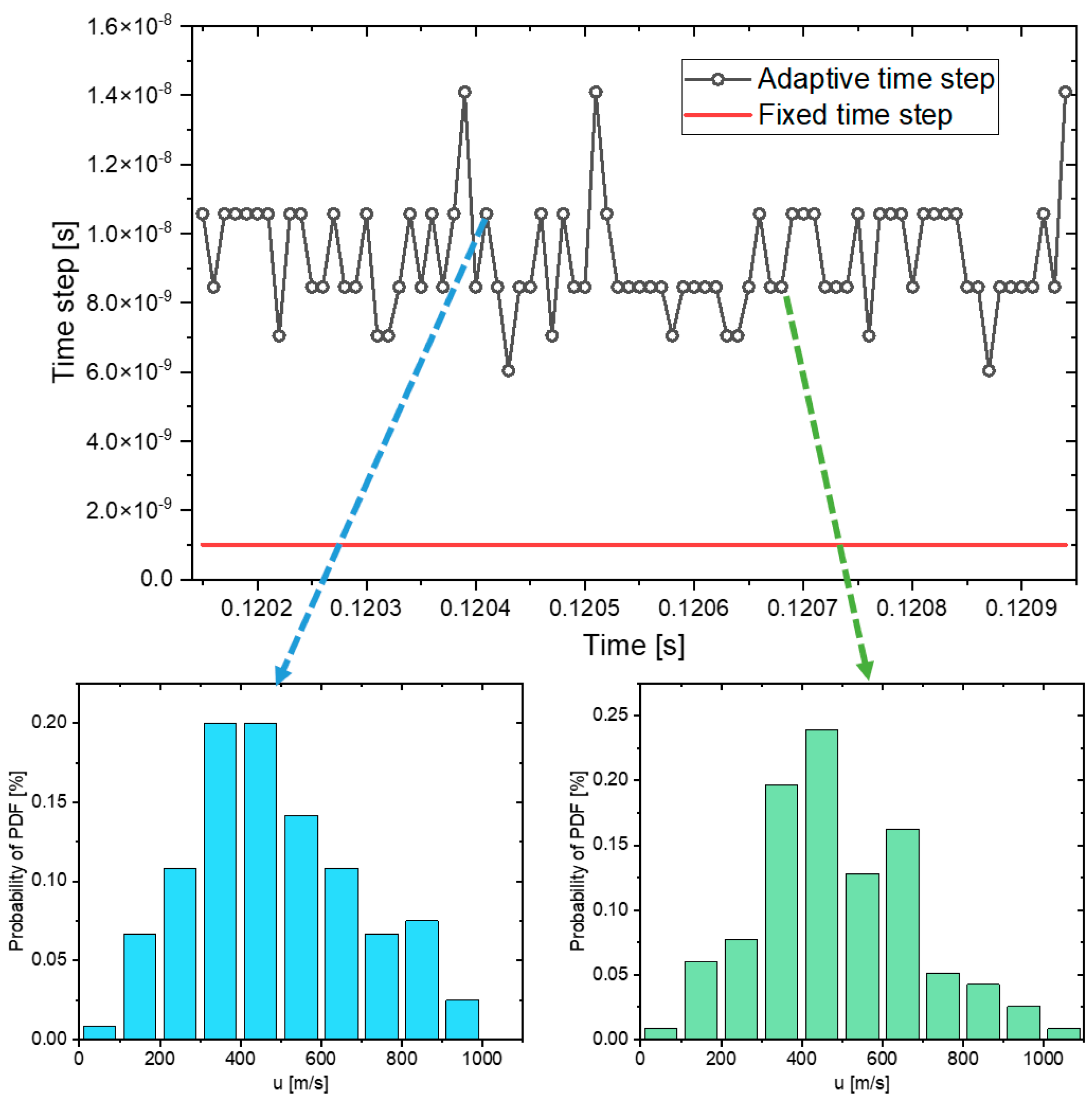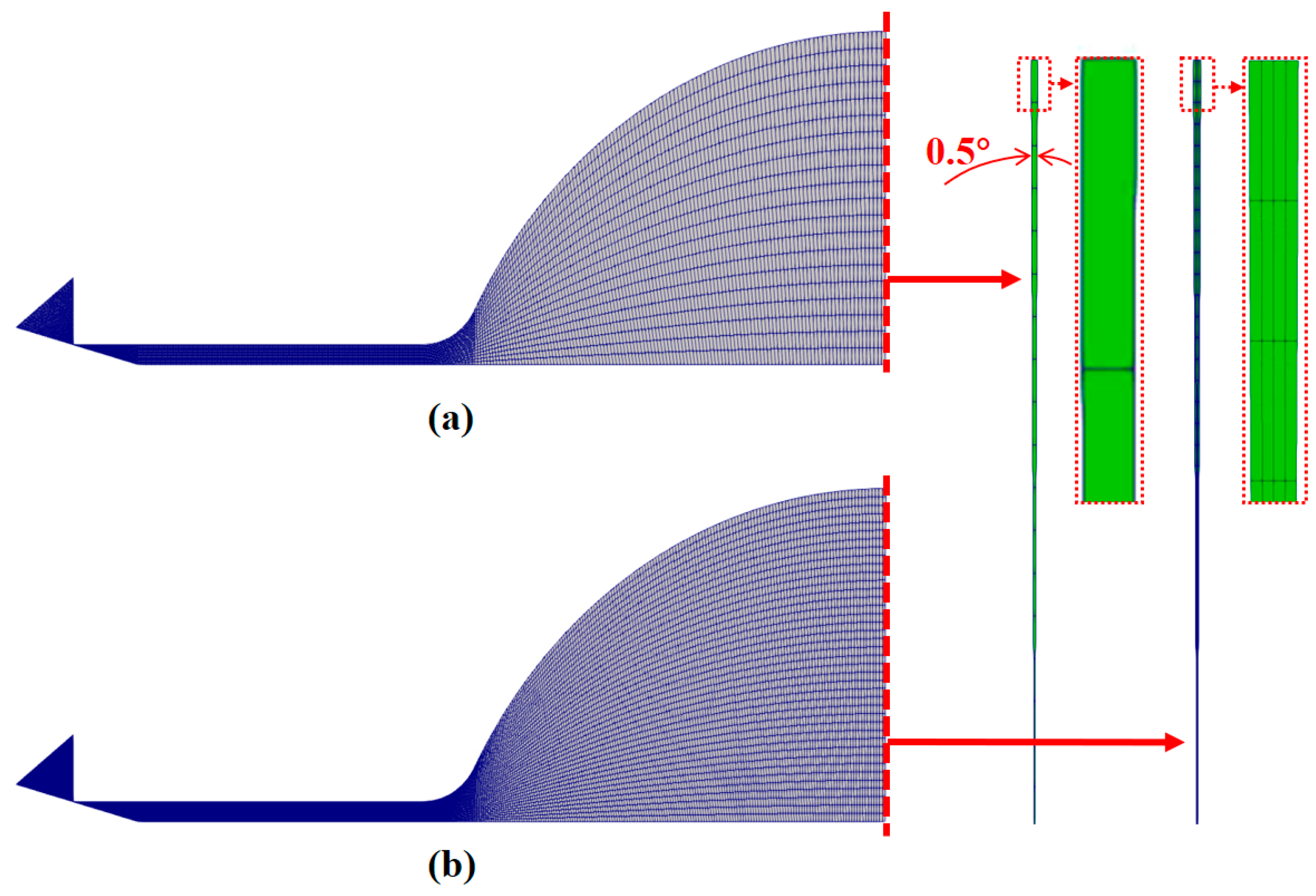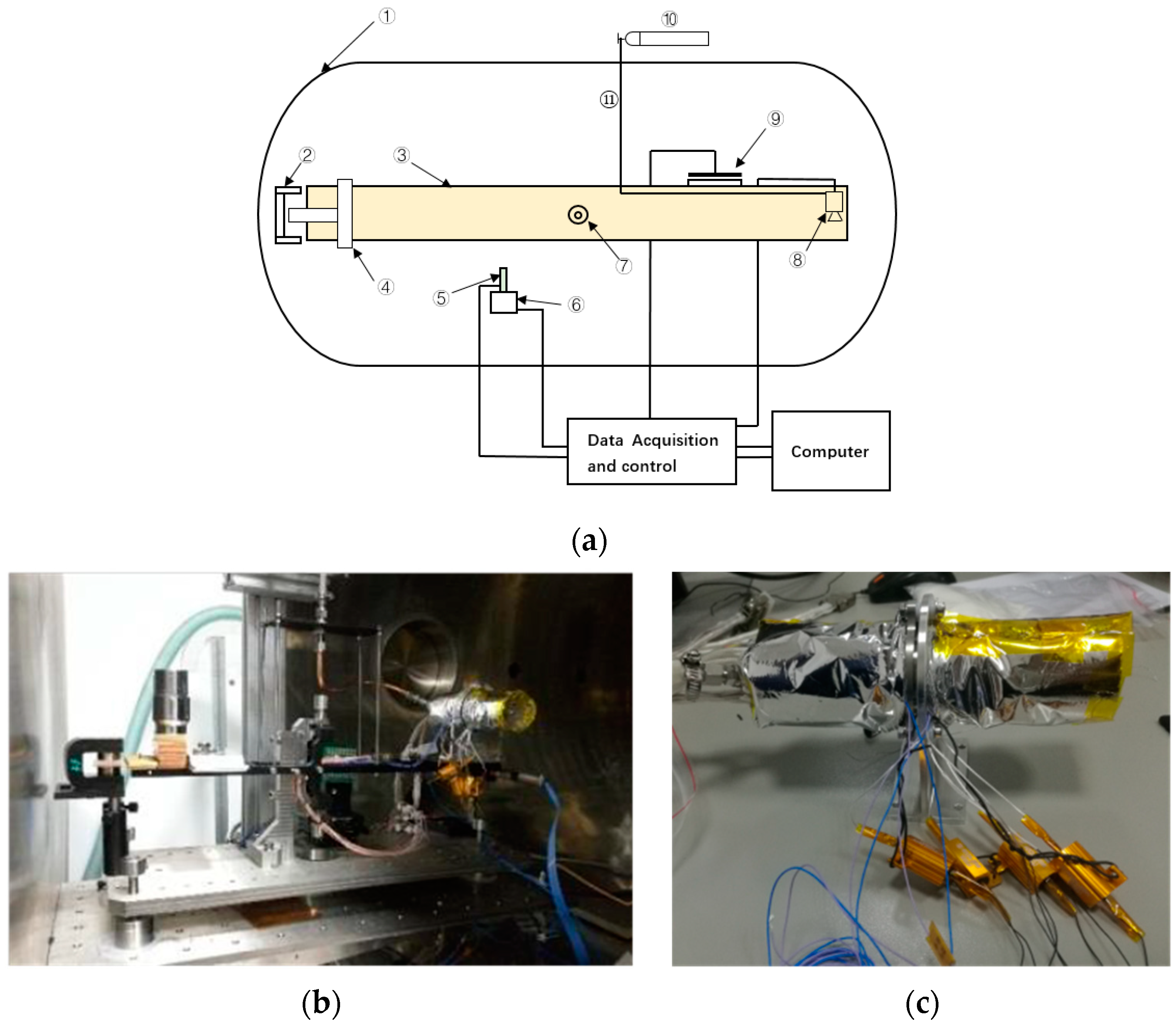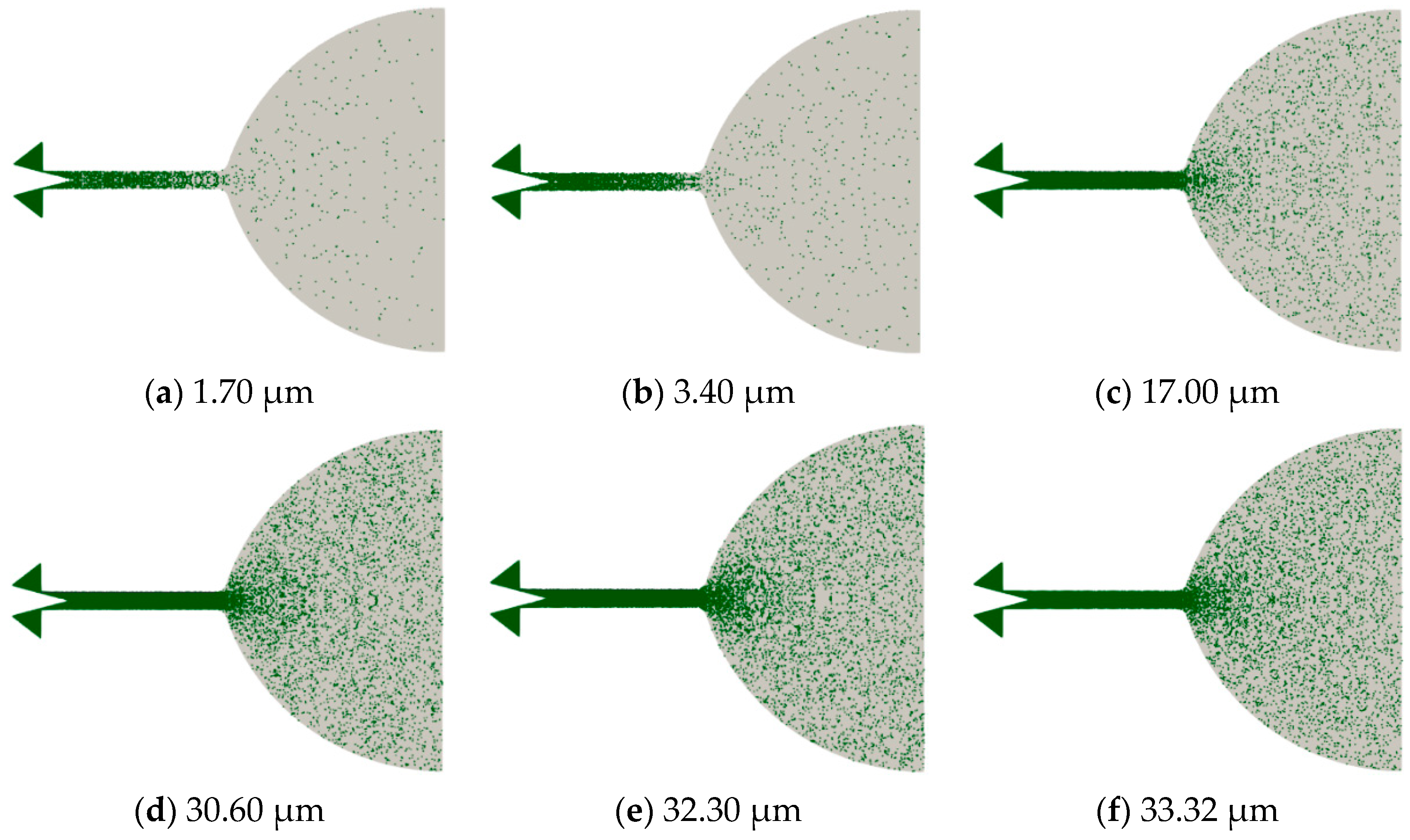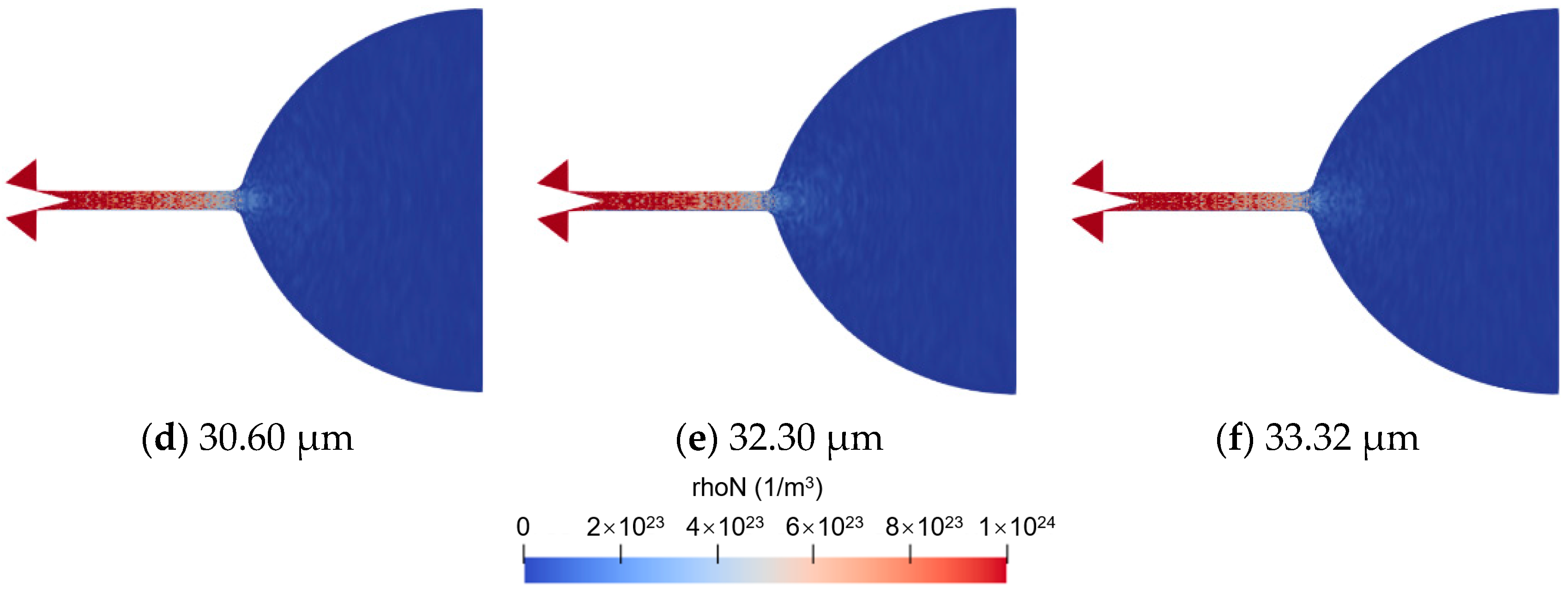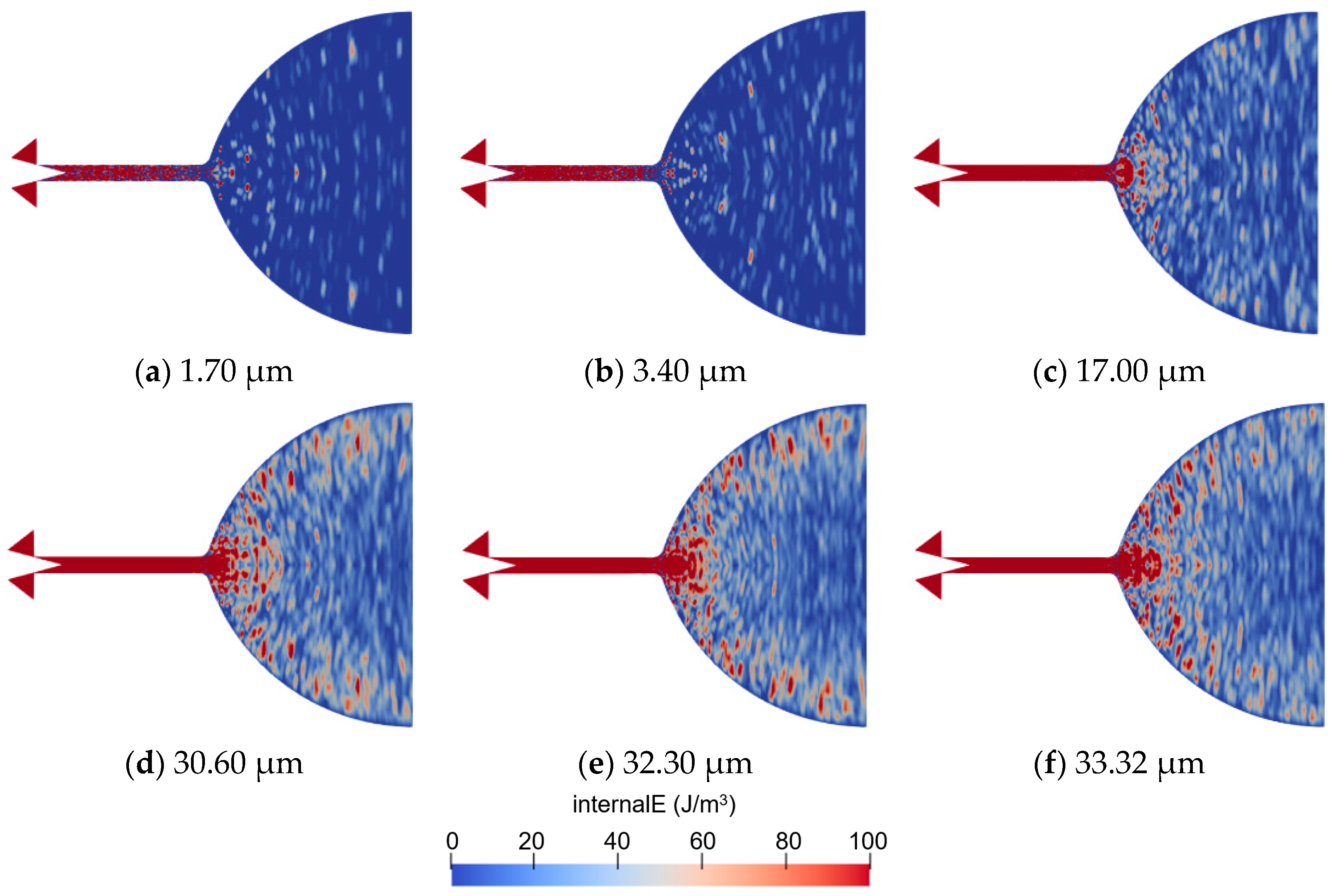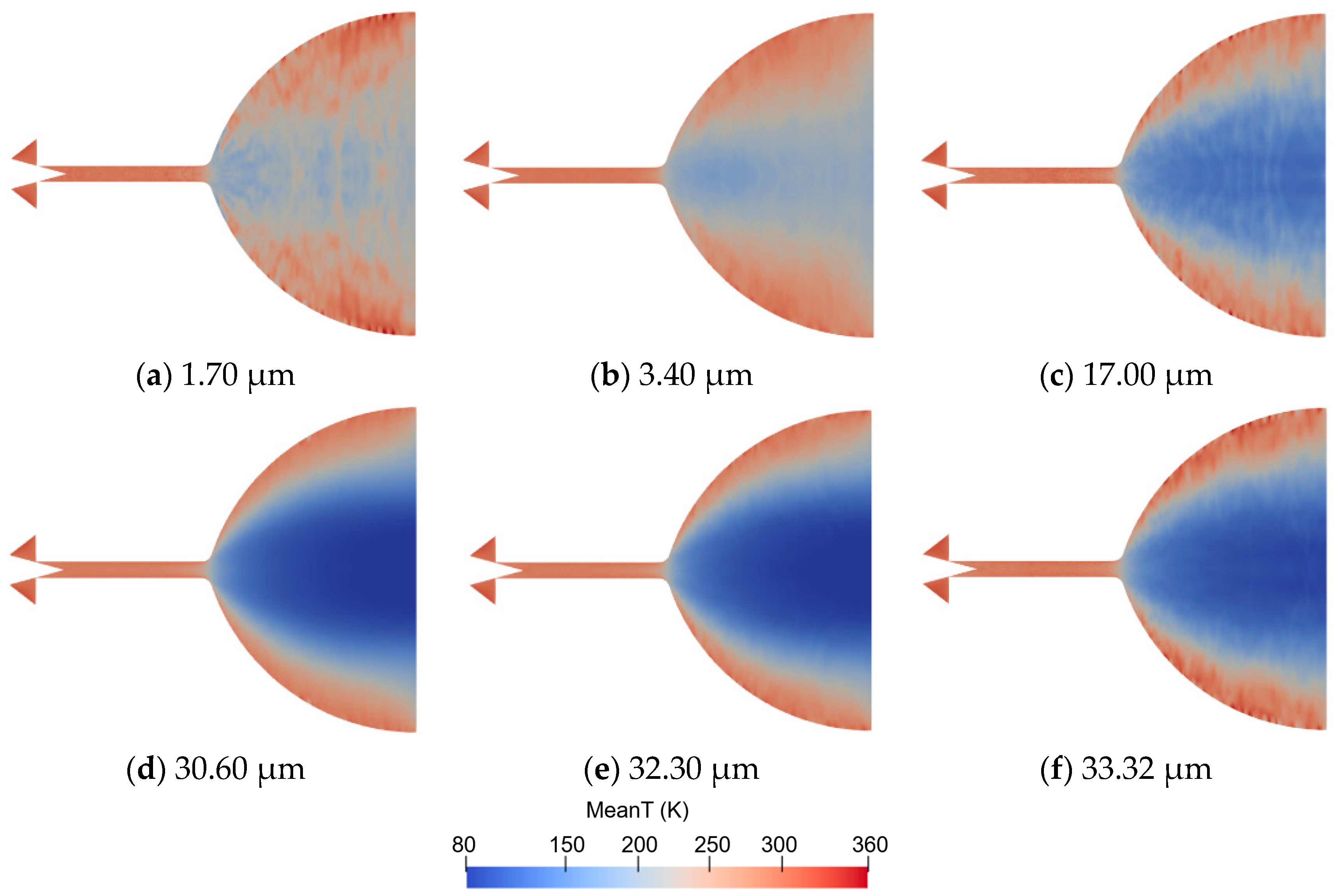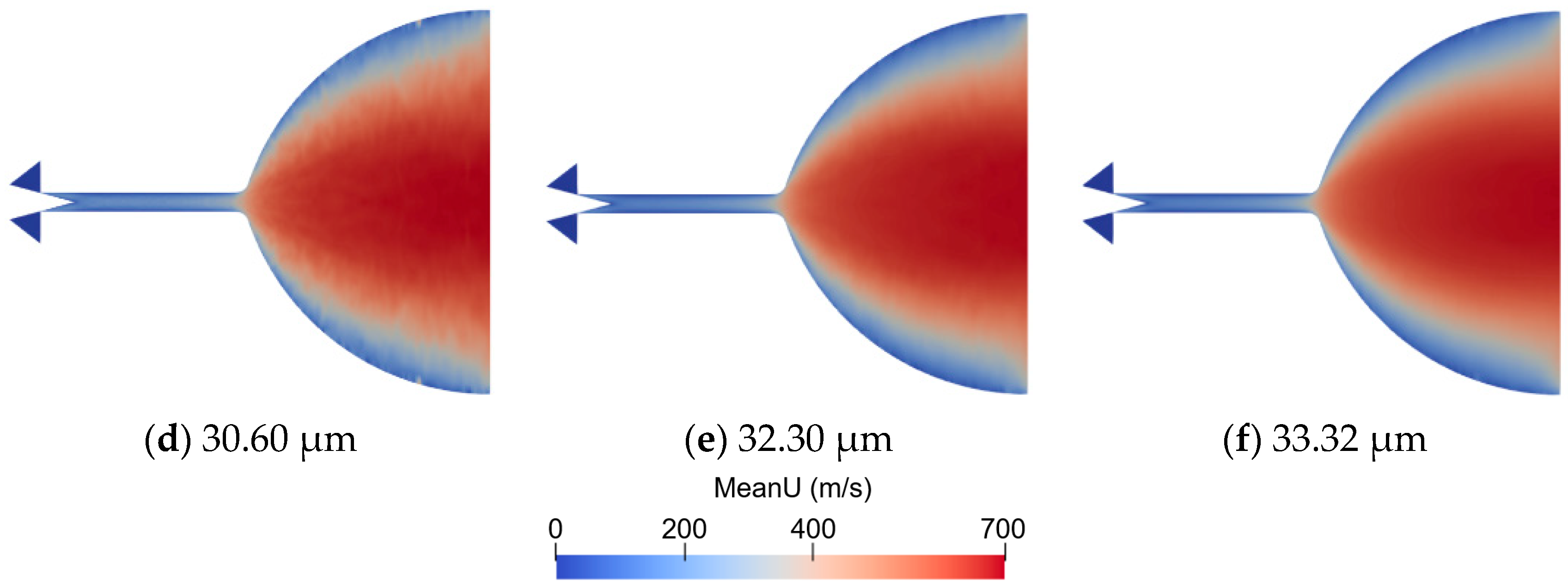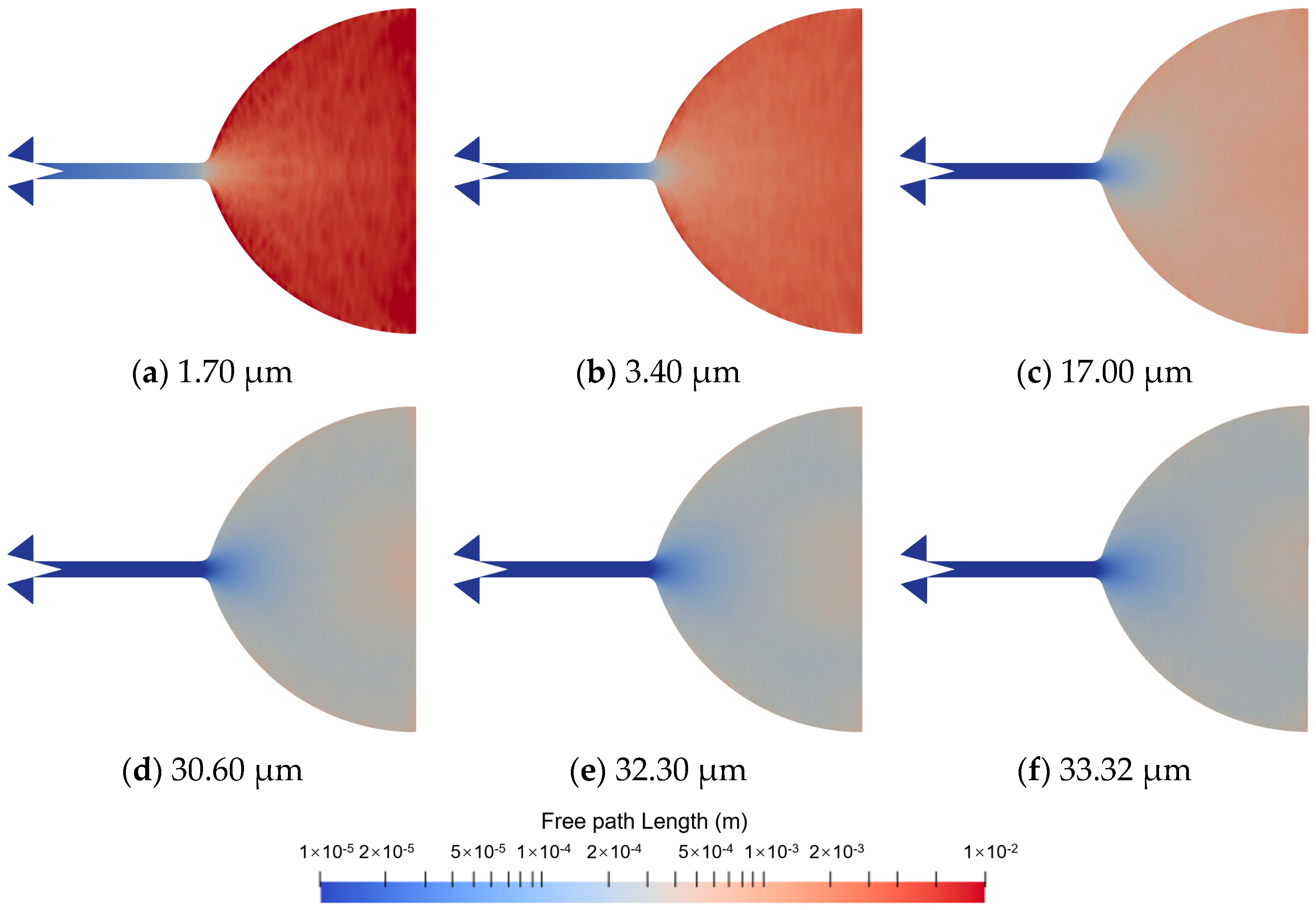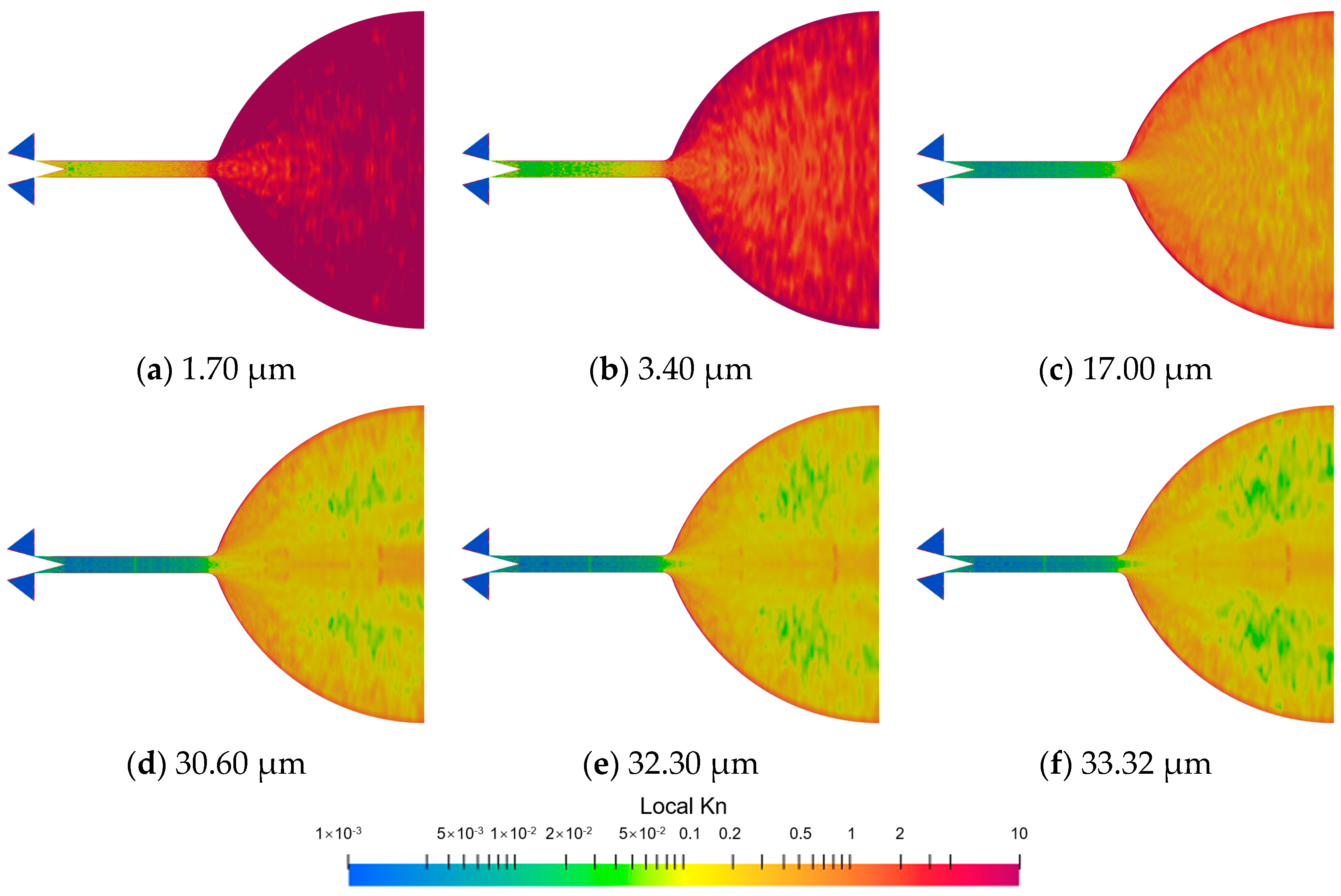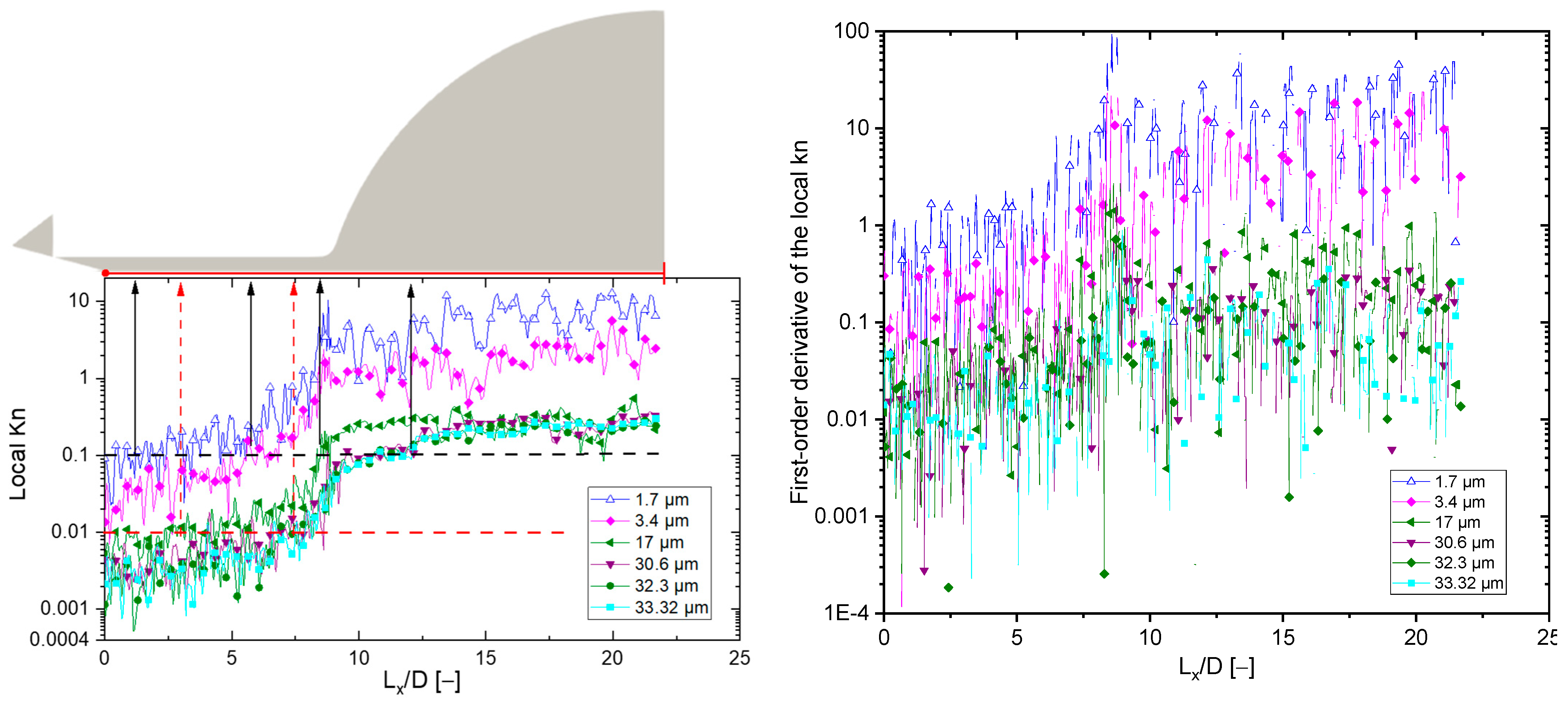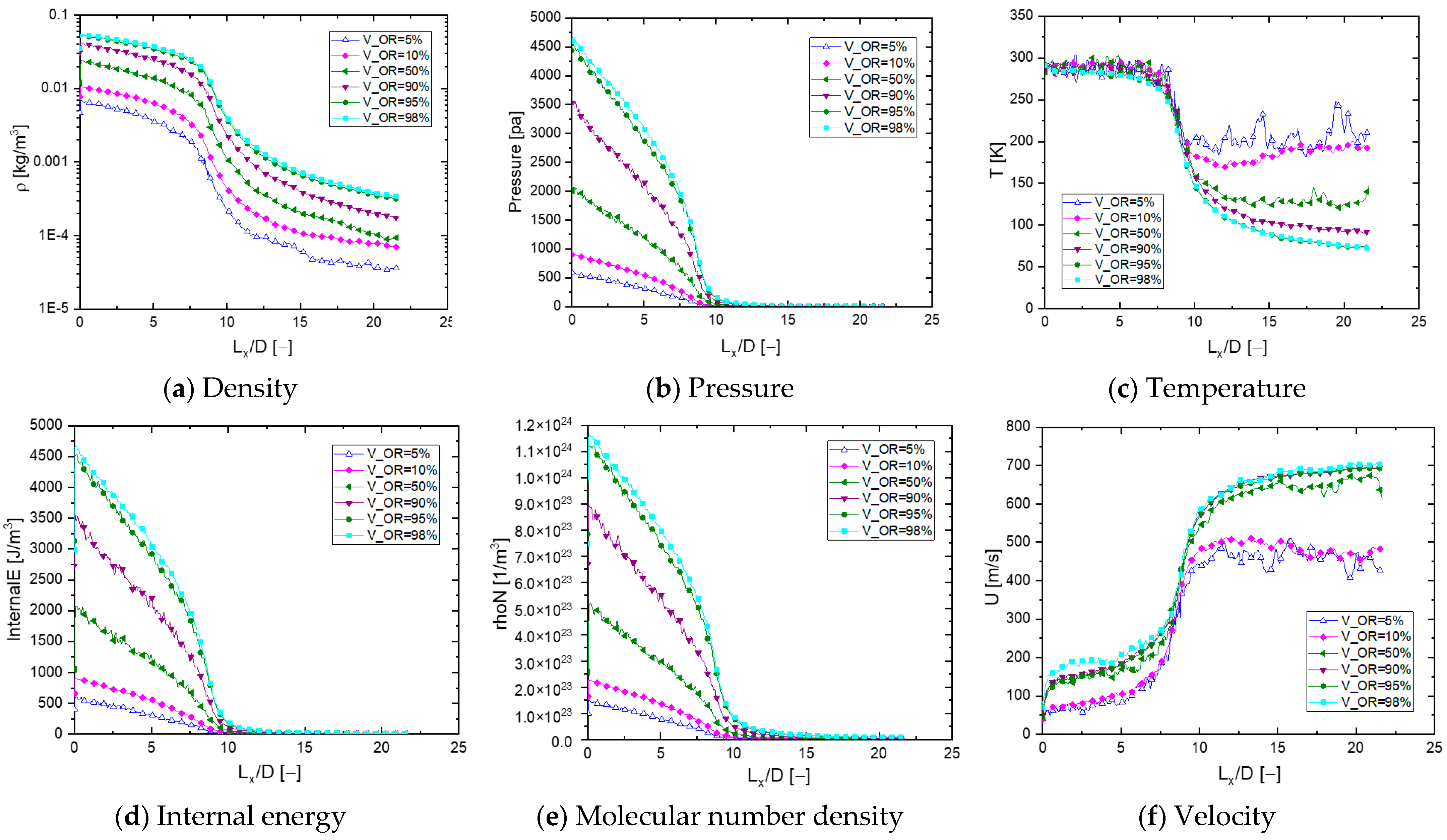1. Introduction
The new generation of space gravitational wave detection, high-precision earth gravity field measurement, high-precision earth observation, and satellite navigation missions have put forward the requirements of ultra-static, low noise, ultra-high accuracy, and stability for satellite platforms. The micro-thruster with high precision and resolution is the key to offset the extremely micro interference of non-conservative forces, such as atmospheric drag, solar light pressure, and cosmic particles’ impact, and make the satellite platform achieve “Drag-free control” [
1]. Micro thrusters generate thrust in the order of milli-Newtons or even micro-Newtons through cold gas acceleration or chemical reaction, which has a relatively high impact, low power consumption, high working reliability, etc. [
2,
3,
4,
5]. The micro-thruster is one of the key components of the cold gas micro-propulsion system.
When the cold gas propulsion system works, gas, e.g., nitrogen and helium, will flow through the micro-nozzle to expand and eject at high speed, thus generating thrust. For flows inside the micro-nozzle, the continuum flow assumption is perhaps no longer valid. The gas molecular nature of the fluid becomes predominant. The particle transport processes in rarefied flows are also of interest but has been less addressed in the previous literature. Fratantonio et al. [
6] used the molecular tagging velocimetry (MTV) to detect the flow rate of argon and helium under low pressure in a 1 mm deep channel. Silva et al. [
7] presented a new time-dependent version of the well-known constant volume method for the accurate measurement of mass flow rates of gases in microchannels. It is difficult to accurately take measurements in rarefied flows in micro-nozzles and micro-channels [
8]. Most scholars adopted numerical simulation methods to study the rarefied flow in micro-nozzles [
9].
Rarefied gas flow at the molecular level follows the Boltzmann equation, and direct simulation Monte Carlo (DSMC) [
10] is an efficient and mature method for solving the Boltzmann equation. Darbandi and Rooh [
11] used the DSMC method to study the influence of different gases, rarefaction degrees, and wall reflection models on the flow field of micro/nanometer nozzles. Zhi Shang et al. [
12] used the DSMC method to calculate the velocity field and temperature distribution around the astronaut re-entry module, which provided some useful information on heat transfer and boundary layer flow fields. Sebastian and Santos [
13] used the DSMC method to simulate convergent and divergent micro-nozzles arranged in arrays. By considering convex and concave divergent surfaces, the influence of contour curvature and discontinuity on the pressure, the surface friction, and the heat transfer coefficient of divergent surfaces was studied.
Previous studies have shown that the micro-thruster structure has an important influence on the internal rarefied flow characteristics. Zelesnik et al. [
14] studied the influence of the nozzle’s geometry on nozzle propulsive force at a low Reynolds number. They showed that conical nozzles can provide the maximum thrust because they have the largest mass flux compared to bell-shaped nozzles for the same inlet conditions. The result of Bayt [
15] indicate that the thrust performance decreases marginally with increasing expansion angle due to the dominance of the divergence losses. The variation is about 0.5% at high mass flow rates and decreases with the Reynolds number until, at the lowest Reynolds number tested, the large expansion angles perform better. Rossi [
16] confirmed the importance of adjusting the geometric characteristics of the micro nozzle to obtain the optimal thrust based on theoretical analysis. Louisos and Hitt [
17] used a continuum flow model to perform a numerical study on 2-D planar micro-nozzles to investigate the effect of the divergence angle and the throat Reynolds number on the thruster’s performance. It was observed that the direct scaling of the divergence angle of a macro-scale nozzle cannot achieve the same effect in a micro scale nozzle. Kn number is used to characterize the rarefied effect of gas flow, which is defined as the ratio of the average free path length of gas molecules λ to the geometric characteristic length L. According to different value ranges of the Kn number, the flow is divided into the following four types of flow regimes: namely continuous flow (Kn < 0.01), slip flow (0.01 < Kn < 0.1), transition flow (0.1 < Kn < 10), and free molecular flow (Kn ≥ 10) [
18]. With the increase of the Kn number, the wall velocity slip and the temperature jump at the wall continue to intensify and have an important impact on momentum and energy transfer in the microchannel [
19]. Michalis et al. [
20] studied the effects of rarefaction on gas viscosity in a long, straight channel using the DSMC method. They found that a Bosanquet-type of approximation describes very satisfactorily the Knudsen number dependence of the viscosity over the entire transition regime. Darbandi et al. [
11] carried out a numerical simulation of the large-scale thin flow regime from subsonic to supersonic in micro/nanoscale convergent divergent nozzles. When Kn exceeds the middle magnitude, the high viscous force generated by the wall boundary layer can prevent the supersonic flow in the nozzle expansion part. Compared with the macroscale structure, the microscale structure has a larger surface area-to-volume ratio, and the wall effect has a more significant impact on the momentum and energy transfer of the flow. The study of Varade et al. [
21] showed that the viscous shear force was the main factor of the pressure drop in extended micro-scale channels. Due to the weakening of convection, increasing the number of Kn increases the wall friction coefficient. When the Kn number is greater than 1, gas density pulsation is weakened, and diffusion transport is proportional to the pressure gradient. Increasing the face ratio of the micro-channel will not only increase the wall friction coefficient and the Nusselt number (Nu) but also will increase the sensitivity to the Kn number [
22]. In addition to the influence of the rarefaction effect and wall effect, the flow inside the micro-nozzle is also affected by wall roughness [
23,
24], fluid–solid heat transfer [
25,
26], and other factors.
The micro-nozzle structure selected in this study (See
Figure 1) includes the micro-channel with a large length-to-diameter ratio (>4) and the bell-shaped nozzle. The micro-channel with a large length-to-diameter ratio can effectively improve the structural strength and service life of the nozzle [
27]. The bell geometry is favored on the macroscale for its flow alignment. The valve needle opening upstream of the micro-channel allows precise control of the nitrogen flow rate to meet the flow control requirements. However, theoretical analysis shows that the distribution range of the average free path length of gas molecules in the current nozzle is wide (10
−7~10
−3 m). The Kn number difference inside the micro-nozzle is more than 10
4, and the flow mechanism covers four flow states from continuous flow to free molecular flow. Darbandi et al. [
28] discussed the flow mechanism division in the micro-nozzle, but its structure is a simple convergent to divergent nozzle, lacking a microchannel. So far, there are few simulation studies on the rarefied flow in the micro-nozzle with a microchannel and needle valve structure [
27], which will increase the rarefied effect and wall effect of the micro-thruster.
The aim of the present study is to analyze the effect of different needle valve opening ratios on the rarefied flow characteristics in a micro-nozzle with a microchannel of a large length-to-diameter ratio, up to 4.5 by the DSMC method. The main geometry parameters of the micro-nozzle are listed as follows: (1) valve needle cone angle is 30°; (2) micro-flow channel inner diameter, length, and length–diameter ratio are 0.6 mm, 2.7 mm, and 4.5, respectively; (3) expansion section length and outlet diameter are 3.8 mm and 6 mm. The particle-based DSMC solver dsmcFoam in the OpenFOAM V7 was used. The spatial distribution of gas molecules, molecular internal energy distribution, mean molecular free path, and local Kn number in the micro-nozzle were calculated. The spatial distribution of rarefied flow was discussed. Statistics were performed on macroscopic parameters, e.g., fluid temperature, pressure, density, and velocity.
3. Results and Discussion
The computational domain of the micro-thruster is shown in
Figure 3. The computational domain model can be divided into four sections such as inlet section, throat, micro-scale channel, and nozzle expansion section. Since the nozzle is an axisymmetric structure, a wedge-shaped computational domain, circumferential angle set to 0.5°, is used in this study. The main structural parameters of the micro-nozzle include the following: (1) valve needle cone angle is 30°; (2) micro-flow channel inner diameter of 0.6 mm, length of 2.7 mm, i.e., the length–diameter ratio is 4.5; (3) the expansion section length of 3.8 mm, outlet diameter of 6 mm. Since the DSMC calculation is applied to the whole area, the continuous flow area in the valve cavity upstream of the throat needs to be minimized in order to reduce the calculation effort, so the area within 0.4 mm upstream of the throat is selected for this calculation. Before the formal calculation, dsmcInitialise is used to set initial conditions such as the temperature of nitrogen molecules and walls, the velocity of the nitrogen molecules, and the number density of molecules at the entrance, and this process took 5 s.
The left side of the calculation domain (See
Figure 3) shows the inlet boundary where the molecular number density corresponding to the actual inlet pressure 0.15 MPa is set to 1.9011 × 10
25 1/m
3. The mass of the nitrogen molecule is 46.5 × 10
−27 kg, and the equivalent diameter is set to 3.17 × 10
−10 m. Since the actual outlet pressure is a vacuum, the molecular number density at the outlet surface is zero. The wall is set to an isothermal boundary of 300 K. The equivalent number of molecules per molecular sample particle is set to 5.5 × 10
8. A fixed calculation time step is used, which takes the value of 1 × 10
−9 s. The flow state in the micro nozzle reaches a quasi stable state at 0.1 ms.
Figure 4 shows the verification of the selected time step during calculation, which compares the time step to the ratio Δx/(3*u
0), where Δx is the applied maximum cell size and u
0 is the most probable velocity. The following histogram in
Figure 4 shows the two velocity distributions in the calculation process, which can calculate u
0. The results show that the calculated adaptive time step is always greater than the set fixed time step, so it meets the requirements.
In the present study, the particle-based DSMC solver dsmcFoam in the OpenFOAM V7 was used. The mesh generation utility, blockMesh, supplied with OpenFOAM was utilized to create parametric meshes with grading and curved edges.
Table 1 lists the different computational domain meshing schemes and the predicted deviation values with respect to the results of Grid 9. In the work on grid independence analysis, the needle valve opening ratio is set to 10%, i.e., the opening displacement 3.4 μm. Based on the comparison results of the gas’s average exit velocity on the outlet face, Grid 5 has a higher computational accuracy (calculation deviation 1.79%) and a relatively small total number of cells. The effect of continuing to increase the number of cells on the calculation results is small, with a relative deviation effect of less than 2%.
Figure 5 shows Grid 1 and Grid 9 in
Table 1, and the grid at the exit section.
In order to verify the accuracy of the current model, a comparison of the simulation and experimental thrust results with a valve opening ratio ranging from 5% to 98% is carried out (
Table 2). As shown in
Figure 6, an indirect force measuring system based on the torsion pendulum platform is established. A high-precision capacitive displacement meter was used to measure the arm displacement. At the same time, a vacuum chamber with a diameter of 1 m and a length of 1.2 m was built to create a real working environment for the thruster as shown in
Figure 6a. The mechanical pumps and molecular pumps were used for vacuuming so that the pressure in the vacuum chamber is less than 1 Pa. The mechanical pump was installed on the air-floating platform outside the warehouse to minimize the influence of mechanical vibration on the force measurement. The force measuring system was also equipped with an on-line damping and calibration subsystem suitable for a vacuum, which can improve the measurement accuracy and achieve a larger force measuring range. As shown in
Figure 6b, the precision-leveled torsion pendulum platform was installed in the vacuum chamber; the micro-thruster was installed at the right end of the swing arm; and the counterweight, displacement meter, and damper were installed on the left side of the swing arm. The micro-thruster was covered by a thermal control, as shown in
Figure 6c. The air supply source was installed outside the vacuum chamber, which was led into the vacuum chamber through hoses and connected to the thruster. All electronic control and data acquisition were controlled with measurement and control software to minimize human interference and improve the automation of the test system. The simulation obtained thrust results that are close to the experimental measurements. When the needle displacement is less than or equal to 3.4 μm, simulation deviations appear to increase up to approx. 28%. The reason is that when the needle displacement is too small, e.g., less than 3.4 μm in this study, the number of nitrogen molecules entering the micro-channel decreases sharply, which affects the calculation accuracy. Moreover, the thrust force at the tiny opening ratio is too small, which may also affect the accuracy of the experiment. The above two reasons cause an increase in the simulation’s deviation. When the needle displacement is greater than 3.4 μm, the simulation results match very well with the experimental results.
It has been shown that the molecular number density is an important parameter affecting the rarefied flow [
37]. The following sections provide a detailed analysis of the flow characteristics within the micro-nozzle and investigate the flow mechanism under different needle displacements. The distributions of the DSMC molecular particles on the axial section of the micro-nozzle at different needle displacements at 0.1 ms are given in
Figure 7. The results show that when the needle displacement is less than 3.4 μm, the nitrogen molecules are mainly concentrated in the upstream volume of the throat and the micro-channel due to the throttling effect. Then the nitrogen molecules quickly fill the entire nozzle space after leaving the micro-channel. As the needle valve displacement increases, the number of nitrogen molecules in the nozzle increases rapidly.
The distribution of the molecular sample particles (
Figure 7) can only provide information on molecular spatial location and qualitative molecular number density. Molecular number density is a parameter that gives a good indication of the local number of molecules. The calculated molecular number density distribution for different valve opening ratios is given in
Figure 8. The results show that the molecular number density in the region near the downstream of the throat is below a 10
23 order of magnitude under the low needle valve opening. The molecular number density field in
Figure 8 is a discrete, point-like, discontinuous distribution due to the use of molecular sample particles to approximate the actual molecules. The molecular number density is directly related to the local pressure and also determines the strength of the intermolecular collisions and the interaction between molecules inside the micro-nozzle. The molecules are mainly distributed in the upper midstream region of the micro-channel. The nitrogen molecular density decreases rapidly from 10
24 1/m
3 as the nitrogen enters from the channel to the nozzle expansion section.
Figure 9 gives the molecular internal energy distribution at different needle displacements. When the needle displacement is below 17 μm, there are only a small number of lower energy (below 40 J/m
3), discrete distributions of molecular sample particles in the nozzle. As the needle valve opening ratio increases, the high energetic molecules near the outlet of the micro-channel gradually increases. When the needle valve displacement exceeds 30.6 μm, the high internal energy molecules in the nozzle tend to diffuse toward the near-wall region of the expansion section, while the internal energy of molecules in the central region of the expansion section is relatively low.
Figure 10 shows the macro temperature field of the gas inside the micro-nozzle. The DSMC calculation results require time-averaged statistics to obtain the macroscopic temperature distribution results. In OpenFOAM, the fieldAverage function object calculates and stores ensemble- or time-based field averages, with optional windowing. It is applicable to all field types, i.e., scalar, vector, tensor, etc. We used 50 DSMC time samples, and the time span across which the average is performed is 2 μs. When the needle valve opening ratio is small, the temperature distribution inside the nozzle is more uniform. With the increase in needle valve displacement, the gas temperature difference between the center and periphery of the nozzle expansion section gradually increased. Obviously, the acceleration of the gas molecules reduces the internal energy in the center of the nozzle expansion. As the needle valve displacement increases to greater than 30.6 μm, the gas temperature in the center of the nozzle drops to about 80 K.
The results of the macroscopic gas velocity distribution inside the nozzle are given in
Figure 11. The acceleration of the nitrogen molecules begins in the region near the exit of the micro channel. When the needle valve displacement is less than 17 μm, the peak velocity in the high velocity gas flow region is low (less than 500 m/s), and the low velocity zone is widely distributed. As the needle valve opening ratio increases, the gas velocity in the nozzle gradually increases.
The mean free path length is the average distance that a molecule travels between collisions, which is an important factor influencing the rarefied degree of fluid. It is determined by the criterion that there is one molecule within the collision tube. The mean free path length can be obtained by the following equation
[
38]. To better show the results of the local molecular free path length in the nozzle, the legend color is set as the log distribution function (See
Figure 12). There is a significant difference between the molecular free path in the micro-channel versus in the nozzle expansion section. The mean free path length in the nozzle expansion section is significantly larger than that in the micro-channel. The free path length of the molecules near the wall of the nozzle expansion section is significantly larger than in the central region. The average molecular free path in the nozzle at needle valve displacements that are less than 3.4 μm is an order of magnitude higher than the value at large needle valve displacements (greater than 17 μm). The smaller the valve opening, the more significant the throttling effect of the throat is, and the smaller the number of molecules entering the micro-channel and nozzle is, thus expanding the average molecular spacing and increasing the molecular free path length.
The local value of the Knudsen number (Kn), a dimensionless number defined as the ratio of the molecular mean free path length to a representative physical length scale, determines the degree of rarefaction and the degree of validity of the continuum model in a particular flow. If the Kn number is near or greater than 1.0, the mean free path of a molecule is comparable to a length scale of the problem, and the continuum assumption of fluid mechanics is no longer a good approximation [
39]. The local Knudsen number is defined as Kn = λ/L, where L is expressed as the scale length of the macroscopic gradients, i.e.,
. The results of the local Kn distribution for different needle valve openings are given in
Figure 13. To facilitate the observation of the location of the different values of Kn, ranging from 0.01 to 10 in the contour plot, the legend color takes the form of a logarithmic function. The results show that when the needle valve opening is less than or equal to 10%, i.e., needle displacement of 3.4 μm, the contour line of the local Kn of 0.01 appears in the region near the throat, and a local Kn larger than 0.1 is in the region upstream of the micro-channel. The region between the above two contour lines belongs to the slip flow regime. At all needle valve opening conditions, the no-slip continuous flow marked in blue in
Figure 13 is distributed in the valve cavity region upstream of the throat. The gas, filled with dark purple, in the nozzle extension region is in the free molecular flow regime, as the value of the local Kn number is greater than 1 and less than 10. When the needle valve opening ratio exceeds 10%, i.e., the needle displacement is larger than 3.4 μm, the slip continuous flow region occupies almost the entire micro-channel, and the extended nozzle area is in the transition flow state. There is no free molecular flow in the micro-nozzle.
To quantitatively analyze the spatial distribution of the flow regime in the nozzle at different needle valve openings, the local Kn number curves at the nozzle axis are plotted in
Figure 14. The horizontal coordinate in the figure is the dimensionless length Lx/D. D is the internal radius of the micro-channel. Lx is the horizontal distance from the valve needle tip. The number of local Kn numbers increases gradually along the nozzle axis toward the outlet boundary. Near the exit of the micro-channel, the rate of increase of the local Kn number is higher than that of other regions. This indicates that the nitrogen molecule expands more rapidly in this region, resulting in an increased mean molecule free path. Combined with the right-side graph, the larger the needle valve opening, the lower the growth rate of the local Kn number (the first order derivative of the local Kn number). As the needle valve opening increases, the partition interface between the slip flow and the transition flow region (Kn = 0.1) then moves down from the approx. 1D position upstream of the micro-channel to the 8D position. In all cases, the flow in the axis of the micronozzle is almost in discontinuous flow only when the needle valve displacement is 1.7 μm. When the needle valve displacement is 3.4 μm, continuous flow develops to 2/3 of the micro-channel length. Continuous flows are developed to the micro-channel outlet with a needle valve displacement greater than 3.4 μm.
Figure 15 shows the macroscopic flow parameters at the axial position of the micro-thruster for different needle valve opening ratios. As the needle valve opening ratio increases, the gas density, pressure, internal energy, and rhoN (i.e., mean molecular number density) in the micro-thruster gradually increases. After the needle valve opening ratio exceeds 95%, the fluid macro parameters remain stable. There are significant fluctuations in the macroscopic gas temperature and velocity values when the needle valve is opened below 10%. This result may be related to the reduction in the number of statistical molecular particles caused by the rarefied flow. When the needle valve opening ratio is less than 10%, the gas exit velocity at the nozzle axis reaches 400 m/s, while the gas exit velocity increases up to 700 m/s as the needle valve opening ratio increased to 90%.
